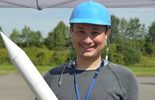
| TOP > CLTP6 > Werner Balogh | ||||||||||||||||||||||||||||||||||||
|
|
|
Statement of PurposeI participated in CLTP 6 to learn more about how CanSat activities could be used for entry-level space engineering education and capacity building. The Office for Outer Spade Affairs under the Basic Space Technology Initiative (BSTI) of the United Nations Programme on Space Applications is aiming to develop an Education Curriculum for Space Engineering. CanSat development could be one of the recommended hands-on training activities. Feedback from CLTP programParticipating in CLTP was a wonderful experience for several reasons: I learned how to build, test and launch a CanSat with my own hands, using again a soldering iron and writing C code for the first time in more than a decade. I got to know and work with space educators from several other countries, learning about their activities and ambitions. It was marvellous to be able to spend time and work with such a highly motivated group of people! This also includes our lecturers and teaching associates, who were always prepared to answer our questions and to help us whenever help was needed. Hokkaido University in Sapporo is a fantastic location and ideal environment for such a course, as is the launch location in Akabira, where the fantastic staff of Uematsu Electric Co. assisted us with building and launching our paper rockets. My tight working schedule did not allow me to spend too much time on preparations for participating in CLTP, however the materials and online lectures made available to us were fully sufficient to come well prepared to Sapporo and to successfully complete all the work steps towards launching a working CanSat. Message for future CLTP participantsCanSat activities are an excellent, cost-efficient and highly motivating starting point for teaching hands-on space engineering skills. CanSat development may be particularly well suited for institutions that are just planning to enter the field of space engineering, possibly with the aim to eventually develop, launch and operate a small satellite. Several of the skills taught during CanSat development can be transferred to real small satellite development. If you are considering to get involved with any of these, I can sincerely recommend that you take a closer look at the CLTP and how it may help you with developing and sharpening the skills you need to reach your goals. | |||||||||||||||||||||||||||||||||
|
Top | Graduates | Program | How to Apply | Contact | Links | Site policy | Privacy Policy | FAQ | Japanese(日本語) | Site Map | ||||||||||||||||||||||||||||||||||||
© UNISEC, all rights reserved. | ||||||||||||||||||||||||||||||||||||




















